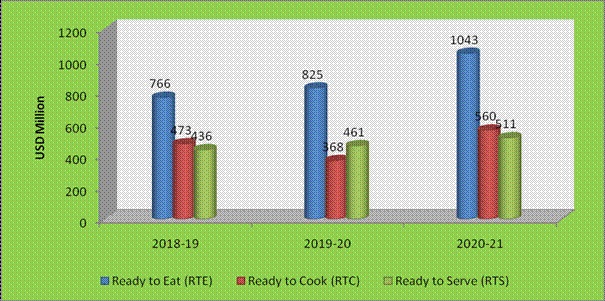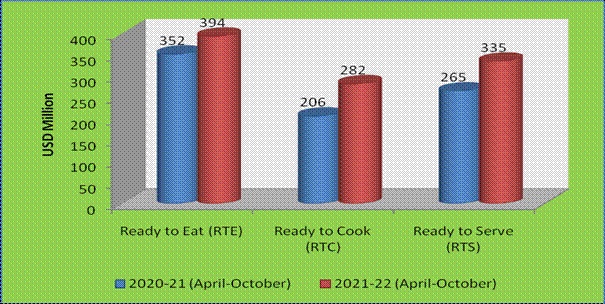India’s Exports of Ready To Eat products rises by 24% to $ 394 million in 2021-22 (April-October) compared to 2020-21 (April-October)
India’s export of
final consumer food products such as Ready to Eat (RTE), Ready to Cook (RTC)
and Ready to Serve (RTS) under the APEDA basket has registered a significant
growth in the last one decade.
With the Ministry of
Commerce & Industry laying thrust on Value Addition of products for
exports, the food products under the RTE category have registered an Compound
Annual Growth Rate (CAGR) of 12 per cent in the last one decade and the share
of RTE in APEDA export has increased from 2.1 per cent to 5 per cent during the
same period.
The export of
products under Ready to Eat (RTE), Ready to Cook (RTC) and Ready to Serve (RTS)
segment have registered an CAGR of 10.4 per cent from 2011-12 to 2020-21. India
exported more than $ 2.14 billion worth of final food products in 2020-21.
Since final food products are time saving and readily available, the demand for
food items under the categories of RTE, RTC and RTS has increased manifold in
recent years.
The export of products
under RTE, RTC and RTS categories rose by more than 23% to $ 1011 million in
April – October (2021-22) compared to $ 823 million reported in April – October
(2020-21). In view of this, export of RTE/RTC and RTS for last three years is
placed in below graph.

Source: DGCIS
According to the
latest Directorate General of Commercial Intelligence and Statistics data,
India exported final food products which includes RTE, RTC and RTS, worth USD
5,438 million in the last three financial three years (2018-19 and 2020-2021).
In 2018-2019, India
recorded RTE exports of USD 766 million, which rose to USD 825 million in
2019-20 and USD 1043 million in 2020-21. Meanwhile, the RTC food products
recorded an export of USD 473 million in 2018-19, USD 368 million in 2019-20
and USD 560 million in 2020-21. A comparative analysis of RTE/RTC and RTS for
the current year, April--October (2021-22) against previous years for the same
periods is placed in below graph. Export value of RTE/RTC and RTS has increased
in 2021-22 against previous year.

Source: DGCIS
The RTS food category
registered an export of USD 436 million in 2018-19, USD 461 million in 2019-20
and USD 511 million in 2020-21.
The products covered
under RTE category, includes Biscuits & Confectionery, Jaggery, Breakfast
Cereals, Wafers, Indian Sweets and Snacks, Pan Masala & Betal Nuts etc. The
Biscuits and Confectionery and Indian Sweets and Snacks constitute a major
share of 89% in the RTE export in 2020-21.
The share of each
category in RTE export are 52.32% (Biscuits & Confectionery), 1.52%
(Jaggery), 4.11% (breakfast cereals), 1.73% (wafers), 37.04% (Indian sweets and
snacks), and 3.28% (Pan Masala and Betal nuts).
The growth rate of
RTE in 2020-21 against previous year was 26% while growth in Biscuits &
Confectionery category recorded at 28.87%, Jaggery at 48.18%, Breakfast Cereals
at 4.24%, Indian sweets and snacks at 29.75%, Pan Masala and B’nuts at 4.2% for
the same period.
Notably more than 56%
of RTE food products were exported to top 10 countries in 2020-21. USA is the
top importing country in four categories of RTE products such as Biscuits &
Confectionery (USD 79.54 million), Breakfast cereals (USD 5.33 million), Indian
sweets and snacks (USD 99.7 million), Pan Masala & Betal Nuts (USD 5.95
million) while the remaining two products under RTE are significantly imported
by Malaysia and Nepal. Malaysia imported Jaggery worth of USD 5.09 million and
Nepal imported Wafers worth of USD 3.5 million in 2020-21.
The major destination
of RTE export as per 2020-21 data are U.S.A (18.73%), U.A.E (8.64%), Nepal
(5%), Canada (4.77%), Sri Lanka (4.47%), Australia (4.2%), Sudan (2.95%), U.K
(2.88%), Nigeria (2.38%), Singapore (2.01%).
The RTC food products
have been growing at CAGR of 7 per cent in the last one decade and the share of
RTC in APEDA export has increased from 1.8 per cent to 2.7 per cent in the same
periods. The major categories of food products covered under RTC are ready to
cook, papad, flours and milled products and powder and starch. The
category-wise share in RTC export is ready to cook (31.69%), papad (9.68%),
flours and milled products (34.34%) and powder & starch (24.28%).
The growth rate of
RTC in 2020-21 against previous year is 52 per cent while category wise growth
rate of RTC is highest for powder and starch (174%) followed by Flours and
Milled Products (36%), Ready to Cook (35%) and Papad (19%) in 2020-21 against
previous year.
Above 74% of RTC food
products were exported to top 10 countries in 2020-21 and USA is the top
importing country of Flours and Milled Products and Ready to Cook from India in
2020-21 while two countries namely UK and Indonesia are at the top in importing
of Papad and Powder & Starch during 2020-21.
The major exporting
destination for RTC export in 2020-21 are U.S.A (USD 18.62 million), Malaysia
(USD 11.52 million), U.A.E (USD 8.75 million), Indonesia (USD 7.52 million), UK
(USD 7.33 million), Nepal (USD 5.89 million), Canada (USD 4.31 million),
Australia (USD 4.2 million), Bangladesh (USD 3.43 million) and Qatar (USD 2.76
million).
In the category of
RTS, the export has been growing at an CAGR of 11 per cent in the last one
decade. The major final food products under the RTS category include jellies,
squash & juices, other beverages, energy products/drinks and ice cream,
soups, sauces, pasta and seasoning. The share of RTS has increased from 1.1 per
cent to 2.5 per cent in last one decade.
The growth rate of
RTS in 2020-21 against previous year (2019-20) is 11 per cent while
category-wise growth rate of RTS is highest for Energy Products/Drinks (31.10%)
followed by Ice Cream, Soups, Sauces, Pasta and Seasoning (19.34%), other
beverages (14.12%).
The rise in export of
agricultural and processed food products has been largely due to the various
initiatives taken by APEDA such as organizing B2B exhibitions in different
countries, exploring new potential markets through product specific and general
marketing campaigns by active involvement of Indian Embassies.
APEDA has also taken
several initiatives to promote geographical indications (GI) registered
agricultural and processed food products in India by organizing virtual Buyer
Seller Meets on agricultural and food products with the major importing
countries across the world.
In order to ensure
seamless quality certification of products to be exported, APEDA has recognized
220 labs across India to provide services of testing to a wide range of
products and exporters.
APEDA also assists in
upgradation and strengthening of recognized laboratories for export testing and
residue monitoring plans. APEDA also provides assistance under the financial
assistance schemes of infrastructure development, quality improvement and
market development for boosting export of agricultural products.
India’s
exports of RTE, RTC & RTS (USD million)
|
|
2018-19 |
2019-20 |
2020-21 |
2020-21 (April-October) |
2021-22 (April-October) |
|
Ready to Eat (RTE) |
766 |
825 |
1043 |
352 |
394 |
|
Ready to Cook (RTC) |
473 |
368 |
560 |
206 |
282 |
|
Ready to Serve (RTS) |
436 |
461 |
511 |
265 |
335 |
Source: DGCIS\

